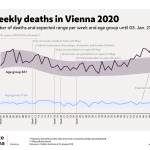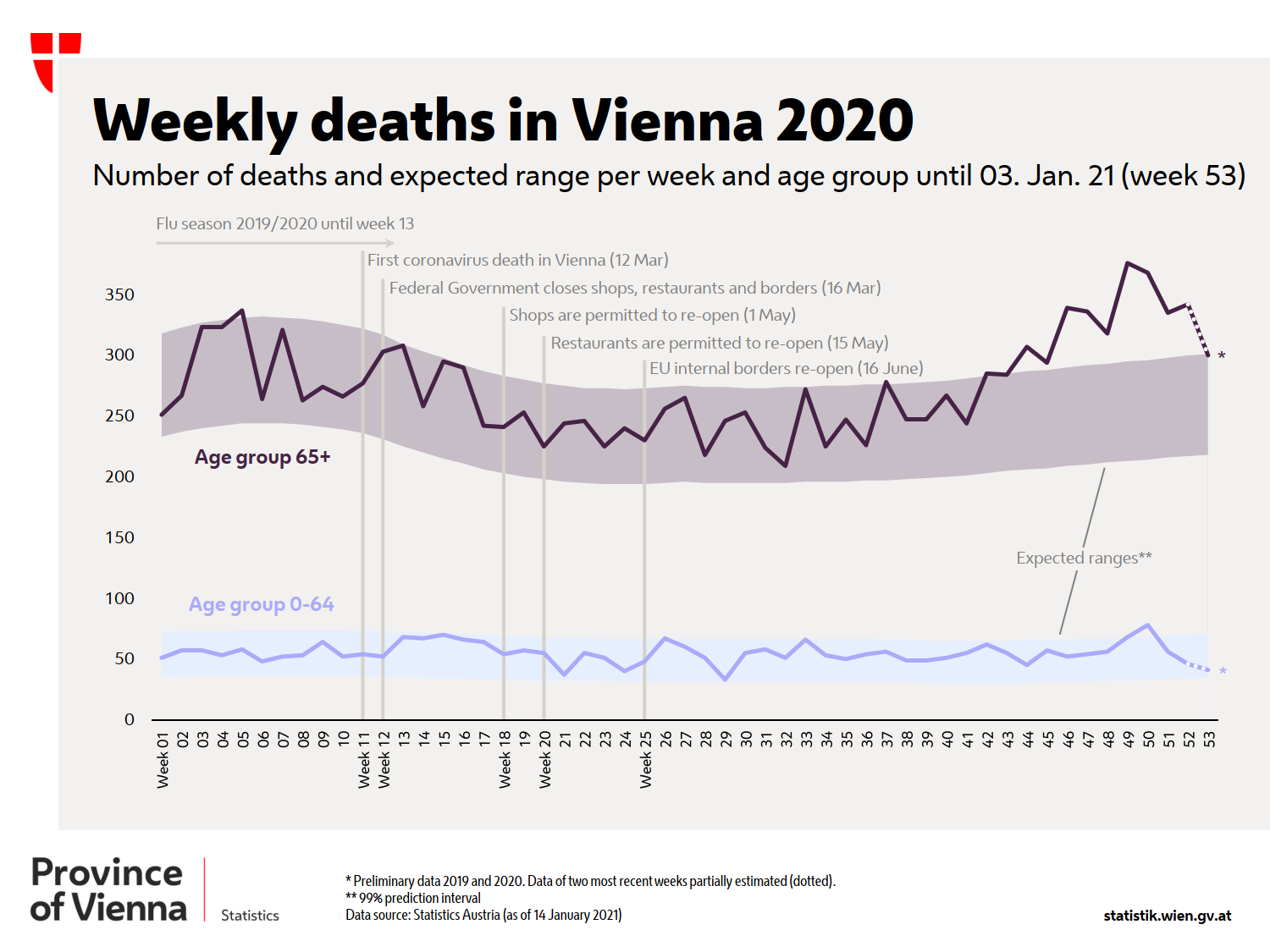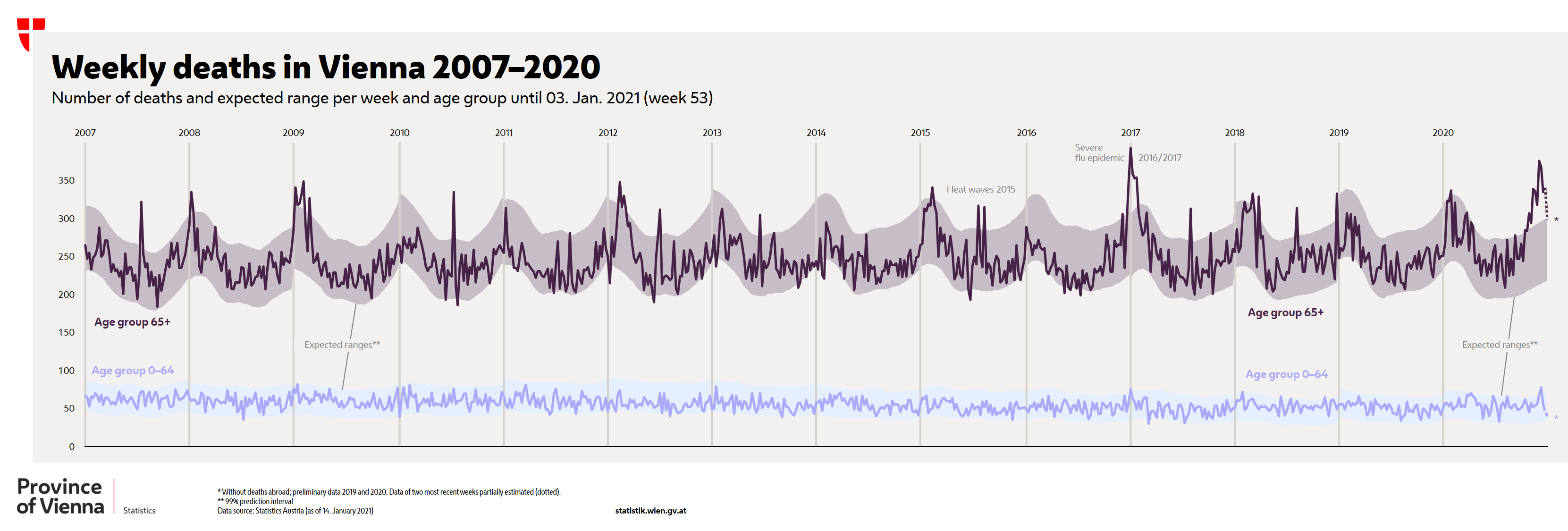
by Ramon Bauer, Peter Frühwirt, Daniel Jost, Roman Seidl, Markus Speringer and Franz Trautinger
First published: 28 June 2020 – auf Deutsch lesen
In Vienna, approximately 16,000 to 17,000 people die each year. That corresponds to 45 deaths per day or 300 per week, on average. However, the actual weekly number of deaths fluctuates widely due to seasonal events such as flu epidemics or heat waves. The need for data analyses on mortality has increased in the wake of the current COVID-19 pandemic. For this reason, Statistics Vienna evaluates mortality trends during the last years.
Mortality analyses by Statistics Vienna
Weekly deaths in Vienna in 2020
Our analyses include all deaths of people with a residence in Vienna who died in Austria. The data originates from the Register of Vital Statistics (ZPR) and is provided by Statistics Austria. Please note that the data for 2020 is still preliminary.

Chart: Weekly deaths in Vienna 2020 (data)
In order to assess whether there was any excess mortality we defined the range of the expected number of deaths. The prediction intervals (“bands”) comprise 99% of the expected values assuming a random and independent distribution of the weekly number of deaths by age group (0 to 64 years or 65 years and older). The “bands” take into account seasonal fluctuations and changes in the population size and age structure – see our method report (in German). This is especially relevant because Vienna experienced strong population growth and shifts in the age structure since the turn of the millennium. Up-to-date data on weekly deaths since 2007 as well as the prediction intervals are published at the Austrian Open Data portal.
Weekly deaths in Vienna since 2007
The following chart shows the number of weekly deaths in Vienna (excluding deaths that happened abroad) for the period from 2007 to 2020. In recent years, Vienna has experienced several short periods of flu epidemics and summer heat waves (e.g. in summer 2015 and in winter 2016/17) during which excess mortality has been registered. In 2020, the COVID-19 pandemic has led to distinct excess mortality in November and December.
Chart: Weekly deaths in Vienna 2007 to 2020 (data)
Scroll to the right or click chart for full screen view
Many thanks to Johannes Klotz and to our colleagues at the Swiss Federal Statistical Office for their expertise and methodological support.
Data
Vienna Mortality Monitoring (Open Government Data, Statistics Vienna)
Weekly deaths in Austria (without deaths in foreign countries) since 2000 (Statistics Austria)
More information
Mortality Monitoring in Austria’s Provinces since 2020
Data monitor: Mortality in European countries and cities since 2015
Information on the Corona pandemic by the City of Vienna (in German)
Method report on mortality prediction intervals (Statistics Vienna, MA 23) (in German)
EuroMOMO (European Mortality Monitoring): Current analysis of mortality in European countries
Corona and fertility in Vienna (in German)
About the Authors
- Ramon Bauer is Deputy Head of Statistics Vienna at the City of Vienna’s Department for Economic Affairs, Labour and Statistics (MA 23).
 @metropop_eu
@metropop_eu - Peter Frühwirt works in the Basic Research Section at the City of Vienna’s Department for Economic Affairs, Labour and Statistics (MA 23).
- Daniel Jost works in the Communication Unit at the City of Vienna’s Department for Economic Affairs, Labour and Statistics (MA 23).
- Roman Seidl works in the Basic Research Section at the City of Vienna’s Department for Economic Affairs, Labour and Statistics (MA 23).
- Markus Speringer works at Statistics Vienna at the City of Vienna’s Department for Economic Affairs, Labour and Statistics (MA 23).
 @MSperinger
@MSperinger - Franz Trautinger is Head of Communication at the City of Vienna’s Department for Economic Affairs, Labour and Statistics (MA 23).




